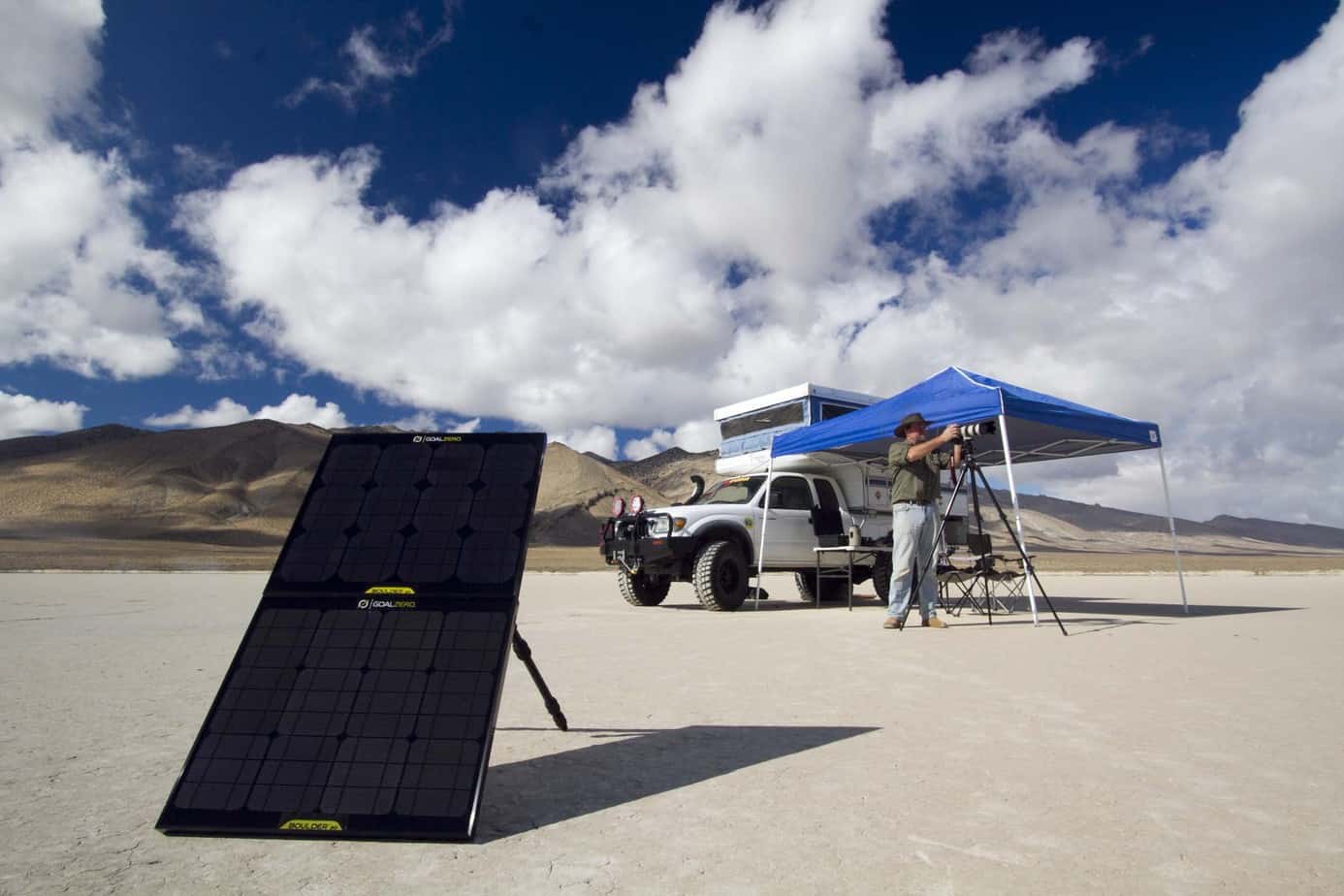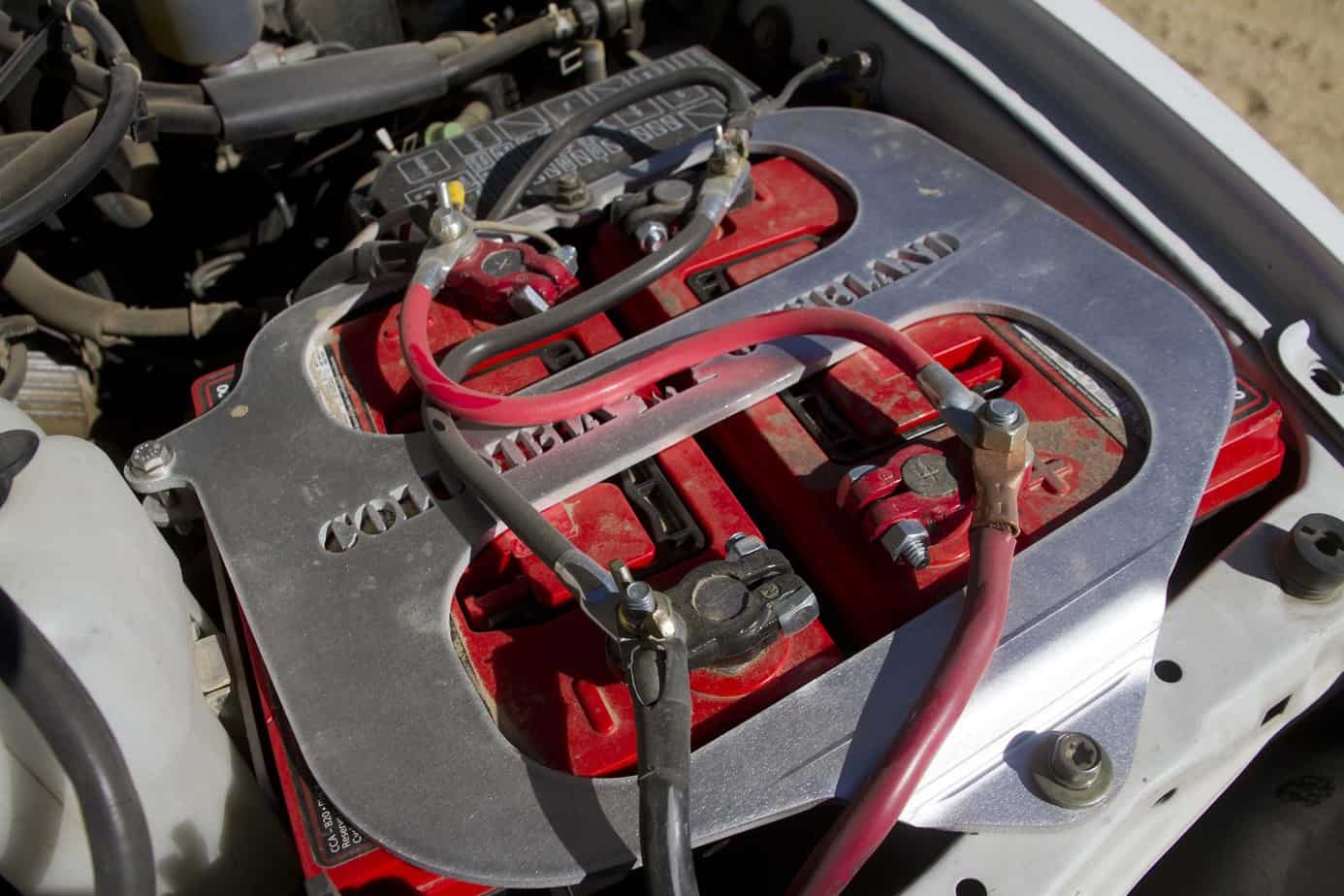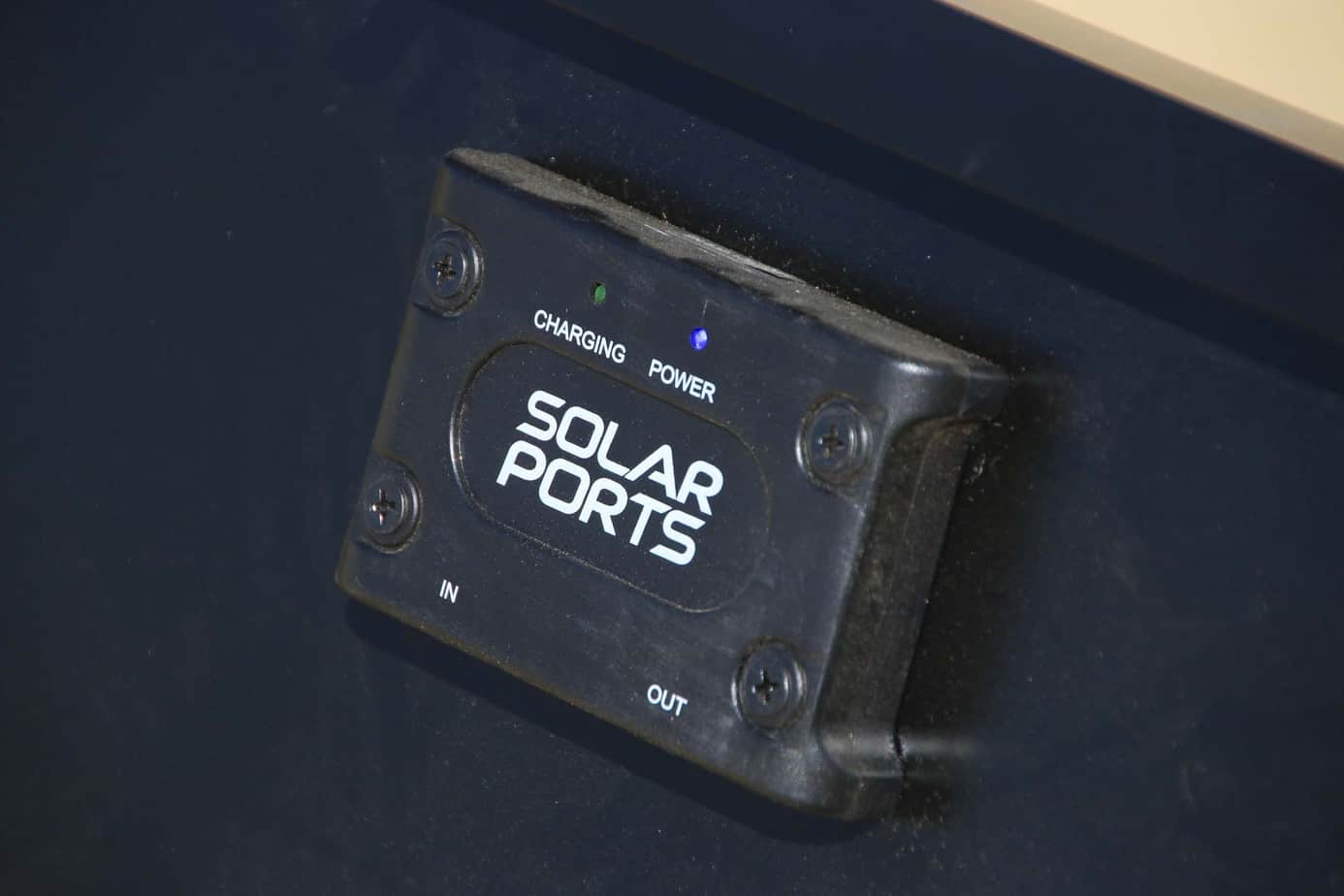I’m not the type of person who feels the need to have every bell and whistle on the planet, nor do I believe that a higher price is necessarily indicative of higher quality (although Wal-Mart-cheap items are often exactly that, cheap crap). My Coleman stove is 30 years old, has been sandblasted and repainted, and still works fine. It fits my needs so why send it to the landfill? However, I am willing to pony up sufficient sums of dinero to acquire the best gear available when necessary. I hold the same philosophy when it comes to modifying my vehicles. I may listen to an inexpensive stereo but I won’t buy a sub-standard recovery strap. What I need in the backcountry are products that are 100 percent reliable.

Above: When camped for extended periods in the same location, solar energy can keep your batteries topped off and your Pacificos cold.
I purchased my Tacoma, a 2002 TRD model, in 2004. It was in pristine stock form, had 17,000 miles on the odometer, and the cost was about 70 percent less than one off the showroom floor. It also came with a Leer canopy and Yakima load bars—a pretty good deal. Within a year I’d fitted it with the best aftermarket suspension I could find, an ARB front bumper and All-Pro Off-Road rear bumper(used), and a Warn winch. I bolted my beloved (dented and scratched) ARB fridge/freezer behind the seat and fabricated a carpet kit in the bed to carry recovery equipment, spare fluids and parts, and a Hi-lift jack—gear I wanted to stow away and forget about. Later modifications included a Safari Snorkel and an ARB air compressor. The goal was to have the truck set up and stocked all the time. I could grab my toolbox, fill the fridge, slide a couple of ActionPackers in the back, and I’d be ready for Baja.
That was 163,000 miles ago and Baja, along with dozens of other trips across the West, have slowly taken their toll. With proper maintenance, the 3.4-liter V6 should be good for 300,000-miles, but the suspension is shot (too many Baja whoops driving like Ivan Stewart), the transmission is howling, and it is generally time to give my old buddy, shall I say, a day at the auto spa.

Though the truck is usually fitted with the Leer canopy, it often hauls a Viking pop-up camper, which doubles as a mobile office. The Viking is an old wood-framed unit and is not perfect, but it provides a comfy out-of-the-weather place to work and sleep. Issues that come into play are the camper’s weight and keeping its battery charged while I’m stationary for several days. In the past, I’ve just run the motor for a half-hour every other day, which does fine. But if I hardwire the system and forget to disconnect the camper, I could end up walking to the nearest road. Regarding weight, at 1,000 pounds the camper is simply not practical for anything more than mild two-tracks. The half-ton load nearly flattens the springs and the wood framing is rather fragile (evidenced by some buckling of the roof). I’m not sure what the solution will be, other than first addressing the suspension, but I’ve always liked the concept of the old Wildernest canopies from the ’80s. Other items I’ll be addressing in the next few months will be fuel capacity and storage options.

With Overland Expo, Easter Jeep Safari, and another trek to Baja in the works, I’ve already tackled a few “electronic” issues. The first was to swap the old battery for a pair of Odyssey PC1400-35 units. I chose the Odyssey because, in my opinion, they are the most reliable batteries on the market. I used Optima for many years but after they moved production to Mexico in 2009 I had several failures and feel the quality has been compromised.
The Odyssey is an absorbent glass mat (AGM) dry cell design rated at 820 cold cranking amps (CCA), a 20-hour capacity, and a 130-minute reserve (see Overland Journal Fall 2010 for battery technology). The AGM feature allows for unrestricted mounting positions and eliminates the spills and mess associated with flooded lead-acid design. Lastly, it fits the Columbia Overland dual-battery tray I picked up a couple of years ago. The other thing I like about Odyssey is that they are manufactured in Warrensburg, Missouri, or Newport, Wales, in the U.K. The pair should serve me well.
Below: An IBS dual-battery relay allows for charging of the camper battery while protecting the main batteries from full discharge.

Above: The Columbia Overland aluminum dual-battery mount utilizes all available space, is designed for two Odyssey PC1400-35 batteries (or other Group 35), and has a clean look.
Columbia Overland’s dual-battery setup is ideal; the only product I’ve found that can shoehorn two batteries into the stock location of a Tacoma. Although there was a fair bit of trimming required on the fan shroud, it fits well, is sturdy, and keeps both batteries very secure. On the end of the cage there is a small sleeve to hold the radiator overflow, but it did need to be modified slightly to keep the reservoir in place. Also, I suggest being very careful if installing this product, as it is very easy to bump the top plate against a terminal which will result in an instant light show (wrapping terminals with tape is suggested). This is a fantastic product.
With regard to battery management, my objective was to keep the camper battery topped off while eliminating the possibility of leaving the truck batteries flat. The answer was an IBS dual-battery relay that links the camper unit for charging and isolates the truck’s batteries from being discharged. The IBS implements MOSFET technology, is simple to manage, and fairly inexpensive.
Below: Output testing of the Boulder 30 (Spring 2011 issue) resulted in 88 percent of the theoretical maximum.

I’ve been camping at Bahia de Gonzaga, Baja, with my Hobie 16, a cooler full of Pacificos, and my friend Don Julio since the late ’80s. Back then the closest ice was in San Felipe (7 hours), I didn’t have a laptop or cell phone, and music came from a Jimmy Buffet cassette tape. During more recent trips I’ve invited a few of Don’s friends, Mr. Pacifico resides in the ARB fridge, Margaritaville is streamed from my iPhone, and I usually work on my laptop at some point each day. Yes, electrical gizmos. As I mentioned, I could run the engine each day, but that magnificent Baja sun is a more appealing option.
Below Left: On the back of the Boulder 30 are “in” and “out” ports that allow multiple panels to be linked together.


Above Right: The Goal Zero Guardian 12-volt charge controller is the interface between the solar panels and the batteries.
The solution came in the form of two Boulder 30 solar panels from Goal Zero. I calculated that the fridge runs about 50 percent of the time, I might fire up the laptop for an hour, and Jimmy joins us in la manana y el noche. While observed output is always less than theoretical (advertised), Graham Jackson found the Boulder 30 to be 88 percent effective in direct sun (Overland Journal solar panel comparison, summer 2011). The twin Boulder 30s, which can be chained, or linked together, should keep the battery charged, and I have a Brunton Solaris 62 fold-up unit if more power is needed. In order to leave the panels hooked up for extended periods without overcharging the batteries, I ordered a Goal Zero Guardian 12-volt charge controller. It’s around 60 bucks and works great. Due to the fact that I waffle between the pop-up camper and the Leer canopy (which usually has kayaks up top), I decided to skip a fancy roof mount for the solar panels in lieu of a tripod-style, ground-based setup. The only negative I’ve found is having to store the panels while in transit and during heavy wind while camped.

Now that I’ve addressed the mandatory requirement (keeping the cerveza cold) the next phase will focus on the drivetrain, suspension, tires, and maintenance items such as wheel bearings, ball joints and bushings, and U-joints. Over the years I’ve done enough trail welding with batteries and jumper cables to also consider the addition of a Premier Power Welder. A set of Falken WildPeak all-terrain tires are already mounted and the UPS guy showed up yesterday with a new suspension system from ICON Vehicle Dynamics and a set of Deaver springs. I’ll be tackling these projects before I head to Overland Expo and Baja. Stay tuned.
Resources:
Odyssey Battery: odysseybattery.com, 800-538-3627
Goal Zero: goalzero.com, 888-794-6250
Brunton: brunton.com, 800-443-4871
IBS: ibs-tech.ch


